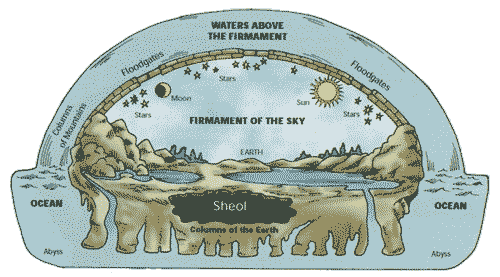Does the Bible teach that the earth is flat?
Many if not most people are unaware that the Bible teaches the earth is flat. All standard Bible references, all standard mainstream non-fundamentalist Bible scholarship acknowledges this. Like on so many other topics, the Bible simply reflects the primitive and mistaken cosmology of the day.

Ancient Israel imagined the earth to be a flat disk (Isa 42.5) resting on a foundation or pillars (Job 9.6). It is surrounded by the ocean (Pss 24.2; 136.6). It has four corners (Isa 11.12; Ezek 7.2; job 37.3; 38.13) and an edge (Isa 24.36) or ends (Isa 40.8; Job 28.4; Ps 48.11; Jer 6.22; 25.32). It also has a center or navel (Ezek 38.12). Except for the implication that Jerusalem is the earth’s center, ancient Israel’s view of the world did not differ from that of other ancient Near Eastern peoples. — Stuhlmueller, Carroll. The Collegeville Pastoral Dictionary of Biblical Theology, p234. (Collegeville: The Liturgical Press, 1996)
[T]he ancient Hebrews considered the universe on a three-leveled structure. The earth was located between the heaven, the upper part, and the underworld, the lowest part of the universe. The earth was regarded as a vast plain, occupied partly by the sea, partly by continents studded with mountains, furrowed by rivers, and dotted with lakes. The horizon encircling the earth quite naturally suggested the idea of a circular shape to the ancient Hebrews. — Stadelmann, Luis I.J. The Hebrew Conception of the World – A Philological and Literary Study, p126. (Rome: Pontifical Biblical Institute, 1970)
The Hebrew Universe: The ancient Hebrews imagined the world as flat and round, covered by the great dome of the firmament which was held up by mountain pillars (Job 26.11; 37.18). Above the firmament and under the earth was water, divided by God at creation (Gen 1.6, 7; cf Pss 24.2; 148.4). The upper waters were joined with the waters of the primordial deep during the Flood; the rains were believed to fall through windows in the firmament (Gen 7.11; 8.2). The sun, moon, and stars moved across or were fixed in the firmament (Gen 1.14-19; Ps 19.4, 6). Within the earth lay Sheol, the realm of the dead (Num 16.30-33; Isa 14.9, 15).” (339)Firmament:
“The Hebrew term raqia’ suggests a thin sheet of beaten metal (cf. Exod. 39.3; Num 17.3; Jer 10.9; also Job 37.18)… Job 26.13 depicts God’s breath as the force that calmed (or ‘spread’, ‘smoothed’) the heavens. Luminaries were set in the firmament on the fourth day of creation (Gen 1.14-19). Rains were believed to fall through sluices or windows in its surface (cf. Gen 7.11).” (338-339) — Achtemeier, Paul J (Ed). The HarperCollins Bible Dictionary. (New York: HarperCollins, 1996)
Hebrew Cosmology: To the ancient Hebrews the earth was the centre of the universe. Above it were the sky and the heavens, and below it were the Underworld, or Sheol, and the waters (eg. Exod 20.4; Ps 24.2; 136.6). (Though at times the Hebrews did cite only heaven and earth as composing the universe (eg. Ps 124.8), actually they held to this tripartite concept (eg. Phil 2.10). The earth, with Canaan at its centre (Ps 74.12), was believed to be one mass of land (cf the ‘ends of the earth’ (Ps 65.5) or its ‘four corners’ (Isa 11.12)) surrounded by an ocean. It rested on pillars (1 Sam 2.8; Job 9.6; Ps 75.3) or on firm foundations (Ps 104.5; but cf Job 26.7).” (298)Firmament:
(Heb raqia; Vulg Lat firmamentum, from LXX Gk stereoma ‘foundation’). The expanse of sky or heaven (Gen 1.8) separating the water below (rivers, seas, subterranean waters) from the waters above (precipitation). In ancient Israelite cosmogony the firmament may have been viewed as a dome or curtain (cf Ps 104.2) of beaten metal (cf Heb rq ‘beat out’; Job 37.18) from which were suspended the stars and planets (Gen 1.14-17). Rain and other heavenly blessings could pour down upon the earth through windows in the firmament (7.11; 2 Kings 7.2; Ps 78.23-24).” (p. 383) — Myers, Allen C (Ed). The Eerdmans Bible Dictionary. (Grand Rapids: Eerdmans, 1987)
Hebrew cosmology pictured a flat earth, over which was a dome-shaped firmament, supported above the earth by mountains, and surrounded by waters. Holes or sluices (windows, Gen 7.11) allowed the water to fall as rain. The firmament was the heaven in which God set the sun (Ps 19.4) and the stars (Gen 1.14) on the fourth day of the creation. There was more water under the earth (Gen 1.7) and during the Flood the two great oceans joined up and covered the earth; sheol was at the bottom of the earth (Isa 14.9; Num 16.30.” (136) — Browning. WRF Dictionary of the Bible. (Oxford: Oxford University Press, 1996)

On the whole, Israel shared the world view of the ancient Near East. The earth was perceived as a flat expanse, seen either in the image of a disk or circle upon the primeval waters (Isa 40.22; Job 26.10; Prov 8.27; cf. ‘circle of the heavens’. Job 22.14) or of an outstretched garment spanning the void (Job 26.7; 38.13). According to HH Schmidt (THAT 1.230-31), these two images, present also in Mesopotamia, derive from different but compatible conceptions of the cosmos which are intertwined without tension in the OT. References to the earth’s (four) corners/rims/hems (‘arba’ kanepot ha’ares; Isa 11.12; Job 37.3; 38.13; cf Isa 24.16_, its end(s), border(s), edges (qeselqesot; Job 28.24; Ps 135.7; Isa 5.26; 40.28; 41.5, 9; Jer 10.13; 51.16), combinations of these images (Jer 49.36; also Ps 48.11 – Eng 48.10; 65.6 – Eng 65.5), its ends (where it ceases: ‘apse [ha]’ares; Deut 33.17; 1 Sam 2.10, etc) its boundaries (Ps 74.17), or its remotest parts (Jer 6.22; 25.32; 31.8; 50.41) depict the vast expanse of the earth and its outer limits, rather than a firm conception of its shape. T Boman (1960: 157-59), has pointed out that naming the outer limits of any area includes the whole area, so that the above terms function almost as synonyms for ‘earth’, ‘world’.The modern concept of an infinite or open-ended universe was not known in the OT; on the contrary, heaven and earth were though to be sealed together at the rim of the horizon to prevent the influx of the cosmic waters (Stadelmann 1970:43).
In contrast to this preoccupation with the earth’s outer limits, a center or navel of the earth (Heb tabbur) is mentioned only once (Ezek 38.12; cf Judg 9.37; Jub 8.19). L Stadelmann (1970:147-54) suggests that Jerusalem (cf Ezek 5.5), and possibly Bethel at an earlier time (cf Gen 28.10-12, 17-18), were considered in this light, in keeping with the views of many ANE and other peoples that their central sanctuary or capital city represented such a center. However this theme is not prominent in the Old Tetsament; that Jerusalem, as the center of worship of the universal God, held a position of central prominence (Isa 2.2-3 = Mic 4.1-2) is a theological rather than a cosmological observation. Over the earth and its surrounding sea(s) arches the firm vault (or firmament. Heb raqia’ (Gen 1.6)) of (the) heaven(s). Together, heaven and earth make up what we would call world, universe, cosmos (Gen 1.1; 2.1, 4; Exod 31.17; Ps 102.26 – Eng 102.25; Isa 48.13; 51.13, 16 and often). Occasionally, earth alone seems to enhance the whole cosmos (eg. Isa 6.3; 54.5; Zeph 1.2-3, 18(?)). The vault of heaven rests on the earth (Amos 9.6; cf. 2 Sam 22.8: ‘the foundations of the heavens’ = the earth) which in turn is firmly set on pillars (1 Sam 2.8) or foundations (Isa 24.18; 40.21; Jer 31.37; Mic 6.2, etc). The foundations are associated with the ‘heavens’ (2 Sam 22.8) or the ‘world’ (Heb tebel; 2 Sam 22.16 – Ps 18.16 – Eng 18.7). The verb yasad ‘to found’ is used with reference to God’s founding of the earth (Job 38.4; Ps 24.2; 102.26 – Eng 102.25, etc).
Somewhat ambivalent is the structure in the place of the sea(s) or water(s), the deep, and the underworld. The seas can be spoken of as a familiar reality, in which the fish and other water creatures swarm (Gen 1.20, 22, 26, etc) and on which humans move in ships (Ps 104.25-26; 107.23; Prov 30.19; Ezek 27.9). As such, the sea forms part of the earth, i.e., the flat surface below juxtaposed to the heavens above. A transitional position between earth and the surrounding sea is occupied by the islands or coastlands (Heb ‘iyyim; Isa 24.14-16; 41.5; 42.4, 10). Elsewhere in the OT the sea(s) or water(s) take on the character of a third cosmic realm in addition to heaven earth, the extension of the cosmic chaos waters surrounding everything… The underworld is often spoken of as part of the earth, a lower cavern, grave, pit (called in Heb Sheol) where the dead lead a shadowy existence; it can even be referred to simply as ‘earth’ (1 Sam 28.13; Ps 71.20; 106.17; Isa 29.4). In other texts, Sheol is treated as a separate cosmic realm besides heaven and earth (Job 26.5; Ps 139.8; Amos 9.2).
The OT conception of the world, then, is basically bipartite (heaven and earth), variously extended to a tripartite cosmos (heaven-earth-sea, or heaven-earth-underworld). Although certain later books and sections (Job, Proverbs 8, several postexilic Psalms, Isaiah 24-27; 40-55) are more explicit in their cosmological descriptions than the earlier documents, the general view of the cosmos does not show any significant change or development throughout the OT period.” (245-246) — Freedman, David Noel (Ed). The Anchor Bible Dictionary. (New York: Doubleday, 1992)
For further information, visit http://www.lhup.edu/~dsimanek/febible.htm and http://www.lhup.edu/~dsimanek/fe-scidi.htm as well as http://en.wikipedia.org/wiki/Flat_earth.
